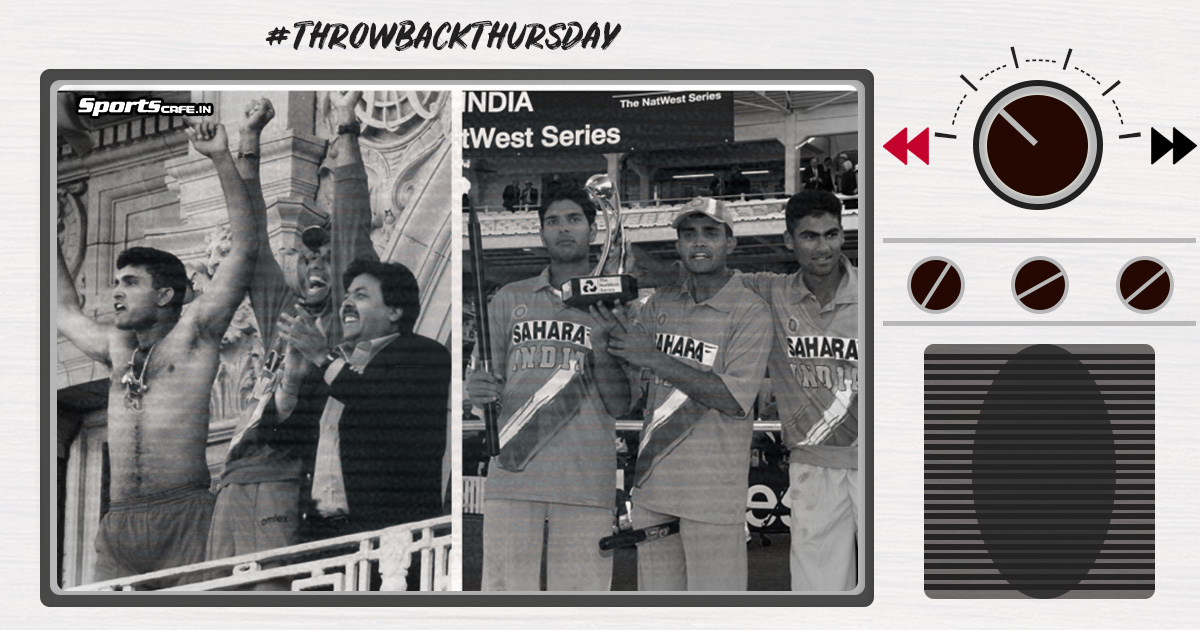Throwback Thursday | India’s iconic 2002 Natwest final victory

SportsCafe
Every Thursday, we present you a moment in history that shaped the way cricket has been played. This day, just like everyone else during their self-quarantine, we are looking at one of India’s historic victories - 2002 Natwest Trophy final win, which showed the whole world that India meant business.
It’s 13 July 2002 and we are at the iconic ‘Lord’s,’ the place where dreams are made of and it's two familiar figures - India and England - facing off against each other. In the west part of London, the sun is heading towards finding out a hide-out spot, as the game puts on a tense-face. India are on 324-8, Zaheer Khan batting, needing 2 off the last 4 balls. Up against him is Andrew Flintoff in a familiar situation and something had to give. The Tables have now been turned and it is a chance for making history - from either end. Flintoff could script an improbable victory, so could Zaheer Khan. The cameras turn towards Naseer Hussain, who now has a decision to make in the last over of the final. It also points to a nervous Sourav Ganguly ready to pull out a celebration. But hold on, before we get to the final play, let us look at what got us to this iconic moment in history.
It’s surprisingly a bright morning in the west of London, with India locking horns with England in the Natwest Finals, with Sri Lanka having crashed out. But the history between these two sides has never been on the bright side. Historically, it has always been England who have dominated the Indian subcontinent, thanks to their clever ‘divide and rule,’ making India one of its historical preys.
Since becoming independent, India have more or less had their sporting front sorted - with cricket becoming one of the staple sports. But how did cricket become one of their main sports? It was all because of the Brits, who brought the game way back in 1700. Since then, it has become a regular sporting fixture in the country. However, they had to wait till 1974 to meet England in an international fixture, but things have looked on the brighter side ever since.
India’s first meet with the British in the World Cup stage came in 1975, when England showed no-mercy, pulling off a 202-run victory at Lord’s. Remember the venue? The venue goes on to become more and more important for the Indian team. In 1983, a youngster in the form of Kapil Dev, along with his team, conquered the English land and the international cricketing world with a World Cup victory.
Moreso, it was at Lord’s which was decisive. In 2002, it was that very venue yet again but India this time faced England in a final and, more importantly, had a chance at redemption. Leading into the latter stage of the tournament, it was a two-men show in England - with Rahul Dravid and Sachin Tendulkar leading the way for the country. While Dravid and an exuberant performer and Yuvraj Singh ensured victory for India in the opener, it was Sachin who carried the momentum forward.
England, in the final, won the toss and elected to bat first. It looked like a wise decision, given India’s faulty batting unit and the home side's batting prominence. Marcus Trescothick scored 109, while the skipper Hussain himself posted 115 runs in England’s mammoth total of 325 for the loss of five wickets. In the era when the scoring rate was always on the edge of 300’s, the one north of 300 looked implausible. One, given that it was in England, where the home team is known to pack a punch. Second, India’s lacklustre batting order. But how did India get here, if their batting looked so kiddish?
The Indian batting line-up looked one-legged in the era, with Sachin tantalizing the opponents with his batting. Some fell in love with his batting while the others dreaded the looks of the bat pointing towards the bowler and the ball beyond the boundary ropes. It was the little master who was causing havoc away from home in Indian colours, smacking some of the revered bowling units around the globe. In comparison to the other deadly bowling units, in this series, he did not have to sweat a lot. Yet, because it was away from home, even worse, in England, he had to bat through his skin to take India home. Until their last encounter against Sri Lanka in the tournament, India never looked rock-solid as a batting unit. Very often, the top-order exited minutes after the toss or the run-chase. The burden was on the little-master once again in the Sri Lanka game.
At 73/2, India were quick off the blocks, but they needed to get a score beyond the reach of a certain Sanath Jayasuriya. Ask the Indian fans, which batsman they fear the most, the answer would be two people - Jayasuriya and Ricky Ponting. From 200-4 in the 33rd over, India came crashing down to 304 at the end of the innings. However, some fantastic bowling from Harbhajan Singh ensured that India got home.
But going into the final, despite having won four out their five previous games, India were never the ‘favourites.’ Such was the occasion of playing the home team at Lord’s. And it was evident from the first-innings that India were never going to be the favourites for how they had bowled in the first innings. Despite his brilliance previously in the tournament, Harbhajan was a shadow of himself with the ball, conceding 53 runs in his ten overs without a wicket. His partner, Anil Kumble, too was lacklustre, given that Hussain was so arrogant with his reverse-sweeps amongst the other shots. India looked destroyed, like they have always in that era, away from home. This was a familiar pattern and that is how the iconic phrase ‘Switch off the TV when Sachin gets out,’ was born.
Okay, 326 is well beyond the time we are in and for an Indian team that has struggled away from home, it looked daunting. It was a familiar figure with the new-ball, Darren Gough. Ganguly and Virender Sehwag threw the opening punch, with shots tantalizingly over the head of English fielders. It was the two Indian men who put on a show, scoring boundaries for fun. Back home, the fans are crying, seeing their team get off to a flyer, never seen before in England.
Desperation was seen from the English camp after the boundary leaks. When Alex Tudor got the bail to fly-off, Indian hopes trusted on one shoulder - Sachin Tendulkar. Sehwag walked off soon, with Dravid and Sachin - India’s last hope. At 132/4, India lost both Dinesh Mongia and Dravid. When the timber came crashing down, Giles and Hussain’s celebration of Sachin’s wicket showed that the game was over. And it also resulted in many a television getting switched off, back in India. But how did India then reach this situation? Well, belief in youth. Mohammad Kaif and Yuvraj Singh put on an exquisite partnership, one that has never seen the light ever since. Slowly yet steadily, India edged closer and closer to the target but one wicket was all it took. At 267/7, it was again in England’s hands.
They needed three Indian wickets and India needed 59 runs more. Flintoff, who celebrated shirtless in England’s win at the Wankhede, looked to become the hero-yet again. He picked up Harbhajan’s wicket followed by Kumble’s. India were still 12 short, with two wickets separating the home side from a win, and India from a heartbreak.
And it all boiled down to this moment, Flintoff with the ball in the final over, Zaheer with the bat. Flintoff, who was at the heart of it in the 3-3 draw against India was back in the death overs, to deliver the telling blow. His shirtless celebrations looked on repeat when he ran his yards to bowl to Zaheer. India still needed 2 runs off four deliveries, with Flintoff running into bowl. This is it, Zaheer could become India’s hero or Flintoff could be a recurring villain in India’s Gotham ODI plans.
Welcome to a moment in history.
— faceplatter49 (@faceplatter49) March 26, 2020
